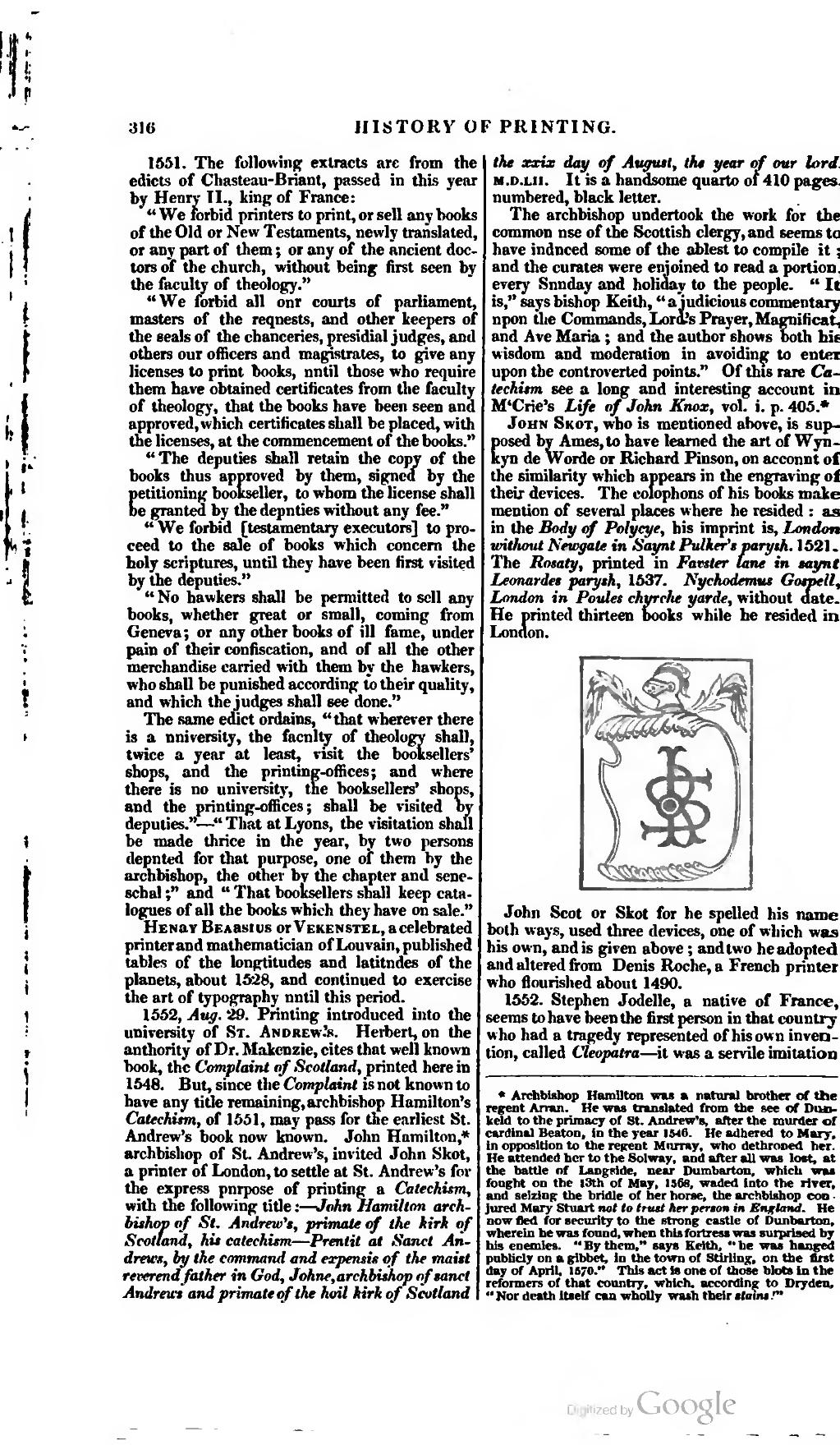ai6
HISTORY OF PRINTING.
1551. The followinfr extracts are from the edicts of Cliasteau-Briant, passed in this year by Henry TI., king of France:
" We forbid printers to print, or sell any books of the Old or New Testaments, newly translated, or any part of them ; or any of the ancient doc- tors of the church, without being first seen by the faculty of theology."
"We forbid all our courts of parliament, masters of the requests, and other keepers of the seals of the chanceries, presidial judges, and others our officers and magistrates, to give any licenses to print books, until those who require them have obtained certificates from the faculty of theology, that the books have been seen and approved, which certificates shall be placed, with the licenses, at the commencement of the books."
" The deputies shall retain the copy of the books thus approved by them, sigfned by the petitioning boolcseller, to whom the license shall be granted by the deputies without any fee."
" We forbid [testamentary executors] to pro- ceed to the sale of books which concern the holy scriptures, until they have been first visited by the deputies."
" No hawkers shall be permitted to sell any books, whether great or small, coming from Geneva; or any other books of ill fame, under pain of their confiscation, and of all the other merchandise carried with them by the hawkers, who shall be punished according to their quality, and which the judges shall see done."
The same ecGct ordains, "that wherever there is a university, the faculty of theology shall, twice a year at least, visit the booksellers' shops, and the printing-oflices; and where there is no university, the booksellers' shops, and the printing-oflfices ; shall be visited by deputies." — " That at Lyons, the visitation shall be made thrice in the year, by two persons deputed for that purpose, one of them by the archbishop, the other by the chapter and sene- schal ;" and " That booksellers shall keep cata- logues of all the books which they have on sale."
Henry Bearsius orVEKENSTEL.acelebrated printer and mathematician of Louvain, published tables of the longtiludes and latitudes of the planets, about 1528, and continued to exercise the art of typography until this period.
1552, Aug. 29. Printing introduced into the university of St. Andrew's. Herbert, on the authority of Dr. Makenzie, cites that well known book, the Complaint of Scotland, printed here in 1548. But, since the Complaint is not known to have any title remaining, archbishop Hamilton's Catechism, of 1551, may pass for the earliest St. Andrew's book now known. John Hamilton,* archbishop of St. Andrew's, invited John Skot, a printer of London, to settle at St. Andrew's for the express purpose of printing a Catechism, with the following title •.—John Hamilton arch- bishop of St. Andrew's, primate of the kirk of Scotland, his catechism — Prentit at Santt An- drews, by the command and expensis of the maist reverend father in God, Johne, archbishop nfsanci Andrews and primate of the hoil kirk of Scotland
the xxix day of August, the year of our lord H.o.Lii. It is a handsome quarto oi 410 pages. numbered, black letter.
The archbishop undertook the work for the common use of the Scottish clergy, and seems tc have induced some of the ablest to compile it ; and the curates were enjoined to read a portion, every Sunday and holiday to the people. " It is," says bishop Keith, " a judicious commentary upon Uie Commands, Lord-'s Prayer, Magnificat, and Ave Maria ; and the author shows both hit wisdom and moderation in avoiding to entei upon the controverted points." Of this rare Ca- techism see a long and interesting account in M'Crie's Life of John Knox, vol. i. p. 405.*
John Skot, who is mentioned above, is sup- posed by Ames, to have learned the art of Wyn- kyn de Worde or Richard Pinson, un account of the similarity which appears in the engraving oi theix devices. The colophons of his bM)ks make mention of several places where he resided : as in the Body of Polycye, his imprint is, London without Newgate in Saynt Pulker^s parysh. 1521 . The Rosaty, printed in Favster lane in saynt Leonardes parysh, 1537. Nychodemus Gospell, London in Ponies chyrc/ie yarde, without date. He printed thirteen books while he resided in London.
John Scot or Skot for he spelled his name both ways, used three devices, one of which was his own, and is given above ; and two he adopted and altered from Denis Roche, a French printer who flourished about 1490.
1552. Stephen Jodelle, a native of France, seems to have been the first person in that country who had a tragedy represented of his own invea- tion, called Cleopatra — it was a servile imitation
- Archbishop Hamilton was a natural brother of the
rerent Arran. He was translated from the see of Doo- keld to the primacy of St. Andrew's, after the murder of cardinal Beaton, in the year IMG. He adhered to Mary, in opposition to the retrent Murray, who dethroned her. He attended her to the Solway, and alter all was lost, at the battle of Langslde, near Dumbarton, which was fought on the l3th of May, 1568, waded into the river, and seizing the bridle of her liorse, the archbishop con . jured Mary Stuart not to trust her person in Enftand. He now fled for security to the strong castle of Dunbaiton, wherein be was found, when this fortress was surprised tiy his enemies. "By them," says Keith, "he was handed publicly on a gibbet, in the town of Stirling, on the first day of April, Ifi/O." This act is one of those blots in the reformers of that coimtry, which, according to Dryden, "Nor death itself can wlioUy wash their •(««."'
